
Pros
- Beautiful, all-metal chassis
- Strong AV output with OLED display, quad speakers
- Super-sharp 9-megapixel webcam
- Massive haptic touchpad
- Long battery life
Cons
- Limited performance from low-wattage RTX 4050
- Too big as a tablet
- Always-on LED on power button gets annoying
On the heels of the 14-inch HP Spectre x360 16 I reviewed earlier this year is its larger linemate, the Spectre x360 16. The two-in-one is just as premium in design and features as the 14-inch but has a roomier, 16-inch display. Inside is the same Core Ultra 7 155H processor from Intel’s latest Meteor Lake series, too, but the size increase also comes with the option for Nvidia GeForce RTX 4050 graphics, giving creators a bit more oomph with demanding graphics apps.
Given the strides Intel has made with its integrated Arc graphics combined with HP setting the RTX 4050 at only 55 watts, the performance bump from the Nvidia GPU is slighter than you might think. Your money might be better spent on upgrading the base IPS LCD to the 2.8K OLED display we tested. It’s spectacular. The speakers and webcam are also excellent, making the Spectre x360 16 a versatile machine for home and work use.
HP Spectre x360 16 (2024)
| Price as reviewed | $1,730 |
|---|---|
| Display size/resolution | 16-inch 2880 x 1800 16:10 120Hz OLED display |
| CPU | Intel Core Ultra 7 155H |
| Memory | 16GB DDR5 RAM |
| Graphics | Nvidia GeForce RTX 4050 |
| Storage | 1TB SSD |
| Ports | Thunderbolt 4 USB-C ports x2, USB-A port, HDMI 2.1, combo audio port |
| Networking | Wi-Fi 6E AX211 (2×2) and Bluetooth 5.3 |
| Operating system | Windows 11 Pro 23H2 |
The Spectre x360 16 starts at $1,600 (and is regularly discounted to $1,200) for a configuration with the Core Ultra 7 155H chip, 16GB of RAM, Intel Arc graphics, a 512GB SSD and a 2,560×1,600-pixel IPS touch display. Our test system features more than $500 worth of upgrades and rings in at $2,130 — and the same $400 discount applies to drop the price to $1,730. The two biggest upgrades are the RTX 4050 GPU for $240 and the 2,880×1,800-pixel OLED display for $150. It also features two other upgrades which both add $70 to the bill: doubling the storage to a 1TB SSD and trading Windows 11 Home for Pro.
A model nearly identical to our test system costs £2,099 in the UK. The Spectre x360 16 is not available with a Core Ultra part in Australia, but you can find 13th-gen Intel models starting AU$2,499.
Spectre x360 16 performance
The Spectre x360 16 got off to a slow start in lab testing with a middling result on Geekbench 6 and a lackluster score on PCMark 10. That it finished behind the Lenovo Yoga 7i 16 with a 13th-gen Core i5 U-series chip, in particular, is both surprising and disappointing. It also did poorly on Cinebench, a test that stresses the CPU. It finished behind the similarly configured Spectre x360 14 on all three of these tests, which raises the question of whether you’d be better off doubling the RAM to 32GB as you get with the 14-inch model rather than upgrading the Intel Arc graphics to RTX 4050. (Scroll to the end of the review to see the results of our testing.)
The 16-inch model’s RTX 4050 GPU did give it a clear edge over the Spectre x360 14 in terms of 3D performance. The Spectre x360 16 significantly outperformed the smaller model on our 3DMark tests, and it produced better frame rates on our gaming tests that were more than double the performance of the Spectre x360 14 which relies on Intel Arc graphics (though this is not designed to be a gaming system).
The 16-inch model averaged 71 frames per second on Shadow of the Tomb Raider at 1080p, while the 14-inch model managed only 31fps. Similarly, the 16-inch model’s score of 161fps on The Riftbreaker GPU test was more than double the 70fps of the 14-inch model. Meanwhile, the 14-inch model was unable to complete our Guardians of the Galaxy benchmark at 1080p with quality settings at High, and the Spectre x360 16 averaged a playable 85fps.
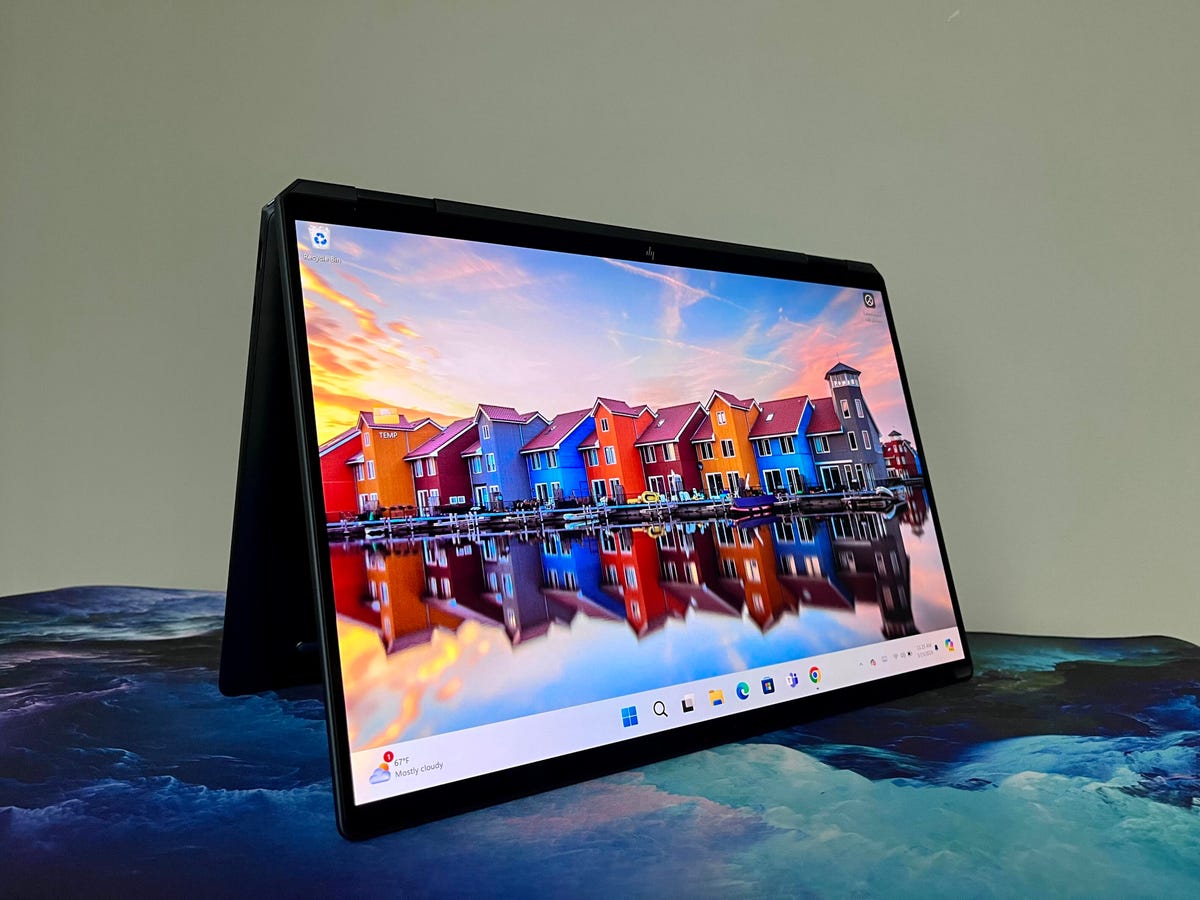
The Spectre x360 16 may have the edge over the 14-inch model with Intel Arc graphics in 3D performance, but it lags behind budget gaming laptops with RTX 4050 graphics in large part because HP set the TGP of the GPU at 55 watts. That’s a fraction of the 120-watt RTX 4050 in the HP Victus 16, for example. Better still for gamers are the Acer Predator Helios Neo 16 and Acer Nitro 16, each of which is set at a maximum of 140 watts.
Although it must power a large, high-resolution OLED display, the Spectre x360 16 lasted more than 10.5 hours on our online streaming battery drain test. That’s an excellent result, but the Apple MacBook Pro 16 and Lenovo Yoga 7i 16 both lasted longer, with the MacBook Pro 16 in a class by itself with a runtime of more than 21 hours. The Spectre x360 16 ran for more than an hour longer than the smaller Spectre x360 14 for the simple fact that it has a bigger battery: a 6-cell, 83-watt-hour battery versus a 4-cell, 68-watt-hour unit.
Premium build and AV output
HP limiting the RTX 4050 GPU to only 55 watts is almost assuredly the result of thermal concerns and the Spectre x360 16’s thin chassis. It’s only 0.8 inches thick, which makes it only a hair thicker than the 0.7-inch-thick MacBook Pro 16. The gaming laptops mentioned above with higher-wattage RTX 4050 GPUs are all much thicker and heavier than the 4.3-pound Spectre x360 16.
The Spectre x360 16 features the same understated design as the 14-inch model. The all-metal, all-black chassis looks sleek and feels solid, and it has a matte finish with a slightly gritty texture that’s a welcomed departure from the usual brushed aluminum look and smooth finish. The matte finish does attract more than its fair share of fingerprints and smudges, but the tradeoff is getting a laptop that looks and feels elegant and stands out. It’s an undeniably cool design.
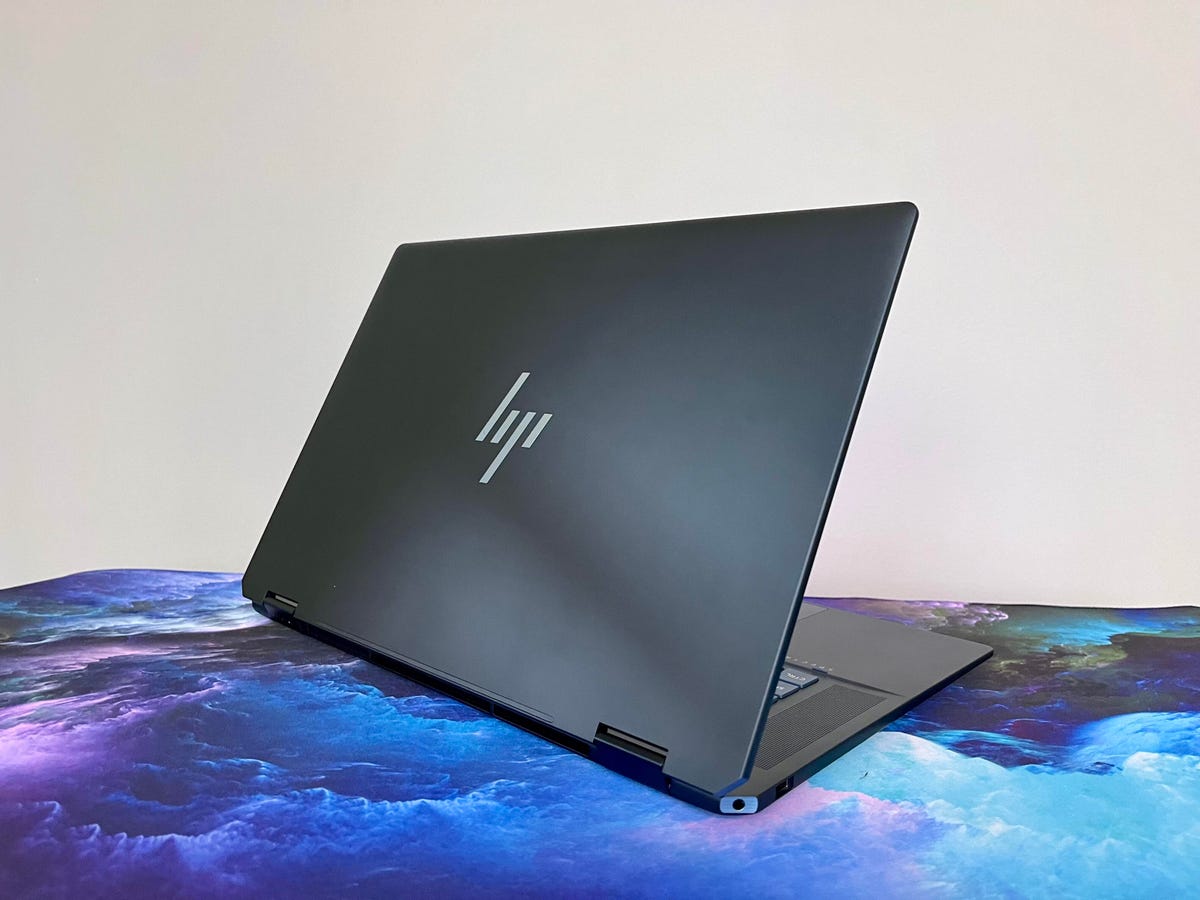
The x360 in the name means the display hinges can rotate all the way around so you can use the system as either a laptop or tablet — with tent and presentation modes in between. Like other 16-inch convertibles I’ve used such as the Lenovo Yoga 7i 16, I found the Spectre x360 16 to be awkward to use as a tablet. It’s a big display to manage with one hand (and arm) while the other hand taps and swipes on the screen. The bezels have a sharp lip where they meet the display, making it somewhat uncomfortable to hold as a tablet. It’s not the seamless and smooth experience you get with an iPad. If you envision giving tablet mode equal time with laptop mode, then I’d steer you toward a smaller, 14-inch model that’s a more natural fit as a tablet. Or plan to use it on a desk or your lap.
HP includes an active pen to aid with tablet use, but there’s no garage to stow it in the system, which increases the likelihood of losing or misplacing the pen. The chassis is too thin to garage the pen, but you can attach it magnetically to the laptop’s right side and keyboard deck, which is fine for keeping track of the pen when you are at your desk.
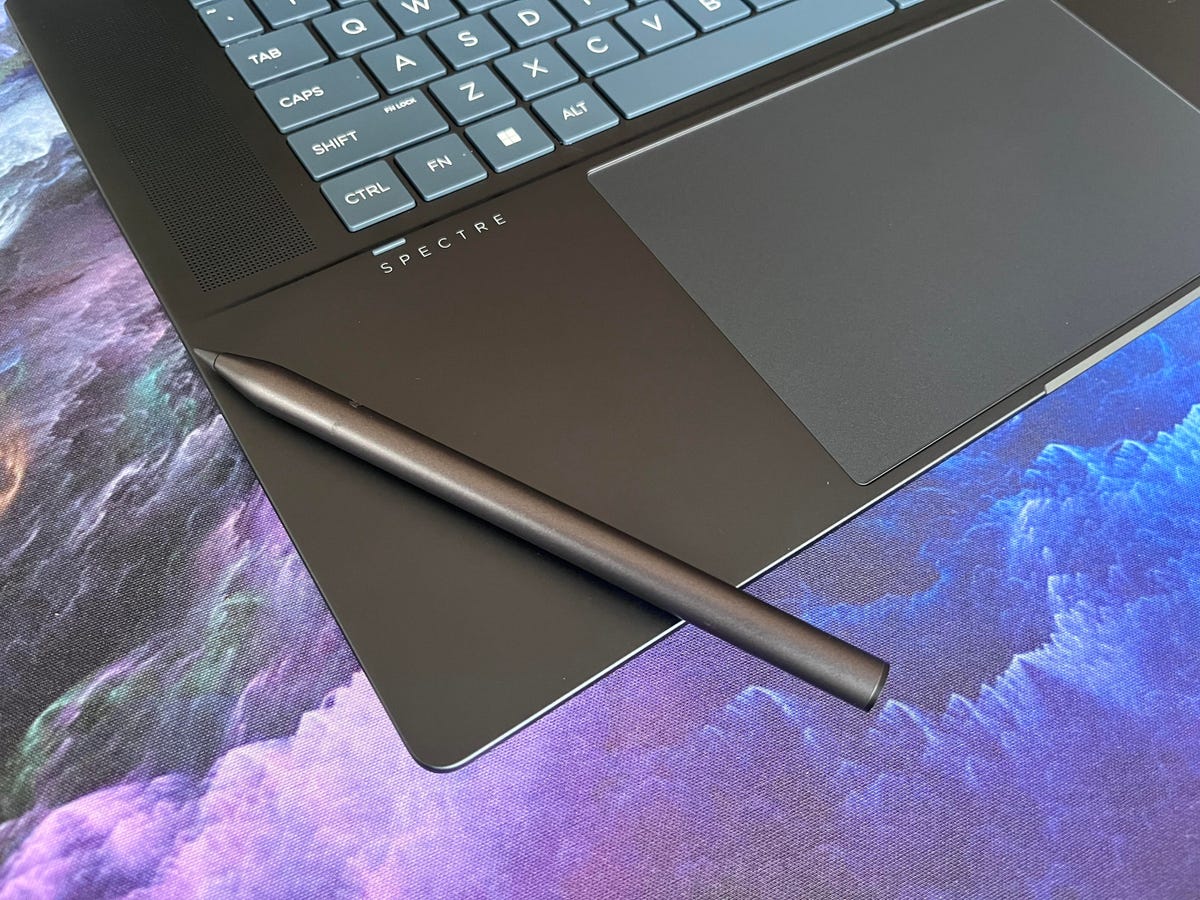
The similarities between the 14- and 16-inch Spectre x360 models extend to the display. Each model we tested featured a 2.8K OLED touch display. The 2.8K resolution offers enough pixels across the 16-inch panel that text looks sharp and inky black and images look crisp and vibrant. The contrast was excellent with bright whites and deep blacks, and the color performance was strong. I tested the display with a Spyder X Elite colorimeter, and it covered 100% of the sRGB and P3 spaces and 94% of AdobeRGB. I measured a peak brightness of 394 nits, which suffices for most scenarios unless you are under direct sunlight but was a bit disappointing since the panel is rated for 500 nits.
The roomy, 16-inch, 16:10 display provides ample workspace, and it also makes the Spectre x360 16 a formidable entertainment laptop. Movies and shows look awesome on the big OLED panel, and the sound from the quad speakers is excellent. This is one of the few laptops I’ve tested that has enough bass response that music playback was enjoyable and didn’t have me immediately reaching for headphones.
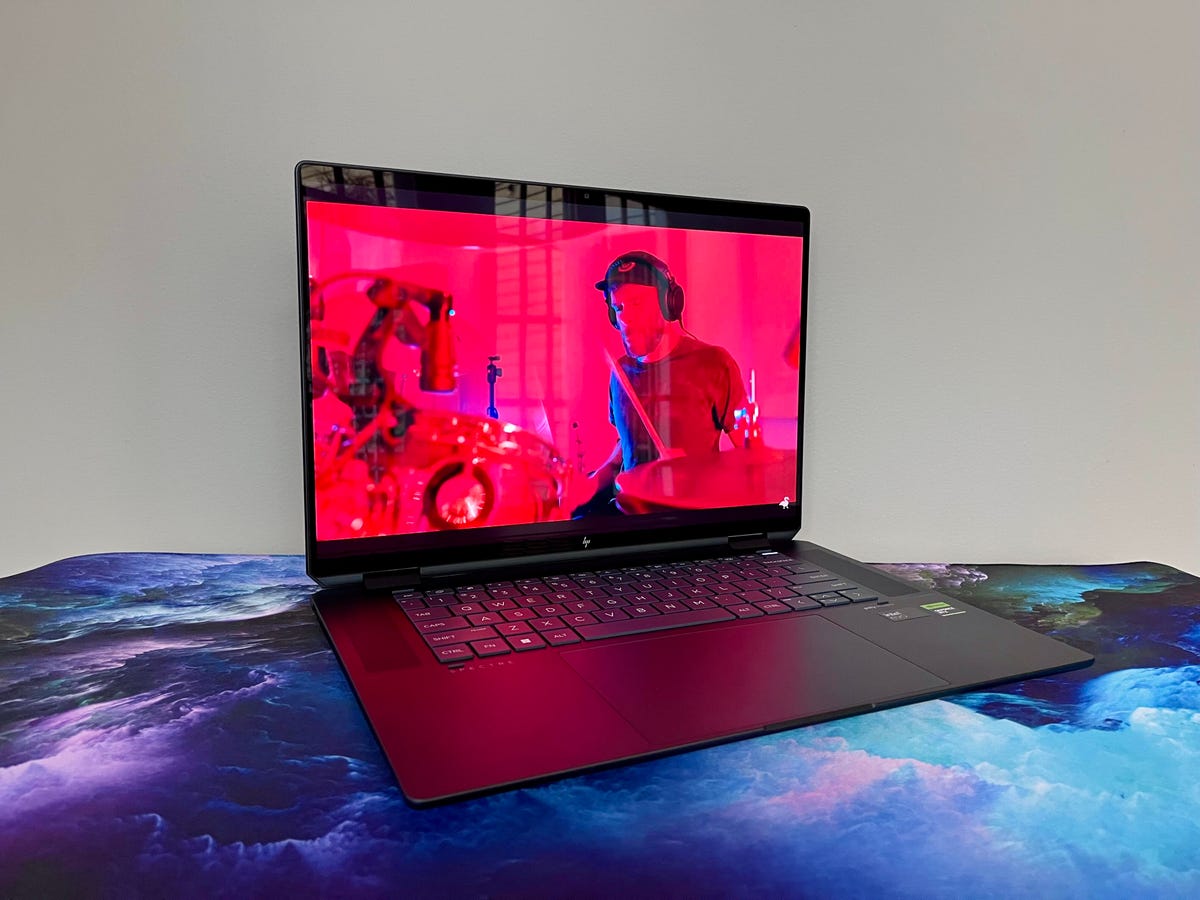
The 9-megapixel webcam above the display produces crisp images. It can capture 1440p video which makes 1080p webcams seem like 720p cameras. With Windows Studio Effects, you can use effects like a blurred background or automatic framing to keep your mug in the picture as you shift and move in front of the camera. The myHP app features AI-assisted audio controls that did an effective job of isolating my voice and reducing background noise. It’s a useful feature for anyone who works remotely and has kids or lives with other small, loud and unpredictable people.
Biometrics is on board with an IR sensor on the webcam for facial recognition logins and a fingerprint reader integrated into the power button. Unfortunately, the power button also features a small LED strip that glows white and cannot be turned off.
The always-on LED is less noticeable when you have the keyboard backlighting on but gets annoying when watching a movie in a dark room. At least the two-in-one design allows you to flip the keyboard out of sight. The keyboard itself feels springy and roomy, and it sits centered below the display. If you plan to use the Spectre x360 16 for data entry, you might bemoan the absence of a number pad that’s often included on large laptops, but I enjoy having the keyboard and touchpad centered on the system.
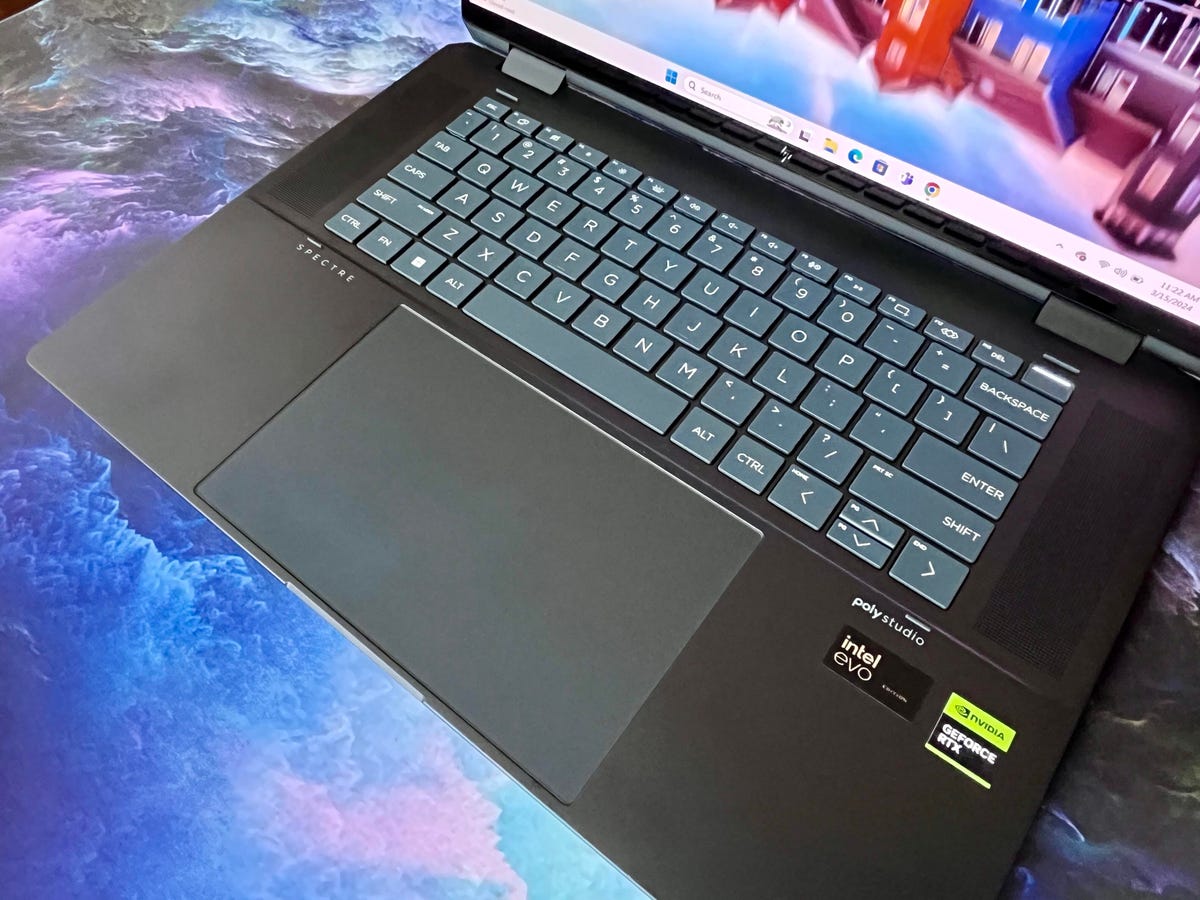
About the touchpad: it’s massive. HP calls it the “world’s largest haptic touchpad for a Windows-based 16-inch PC” and I believe it. It’s gigantic but does a good job of palm rejection so that I wasn’t moving the cursor around by accident. The touchpad features haptic feedback from Elan and feels accurate and lively. The haptic feedback feels much better than a mechanical click would on such a large touchpad because you don’t get the diving board effect where clicks feel too firm near the top of the touchpad and too soft near the bottom edge. You can adjust the intensity of the click response to your preference.
The touchpad also features gesture controls for volume and brightness. In the myHP app, you can set the left edge of the touchpad as a slider to adjust display brightness and the right edge for volume. The haptic response for each slider is pretty cool with these tiny pulses as you move your finger up and down, but I doubt I’d end up using either since tapping the Function buttons for volume and brightness on the keyboard is just as easy and an ingrained habit.
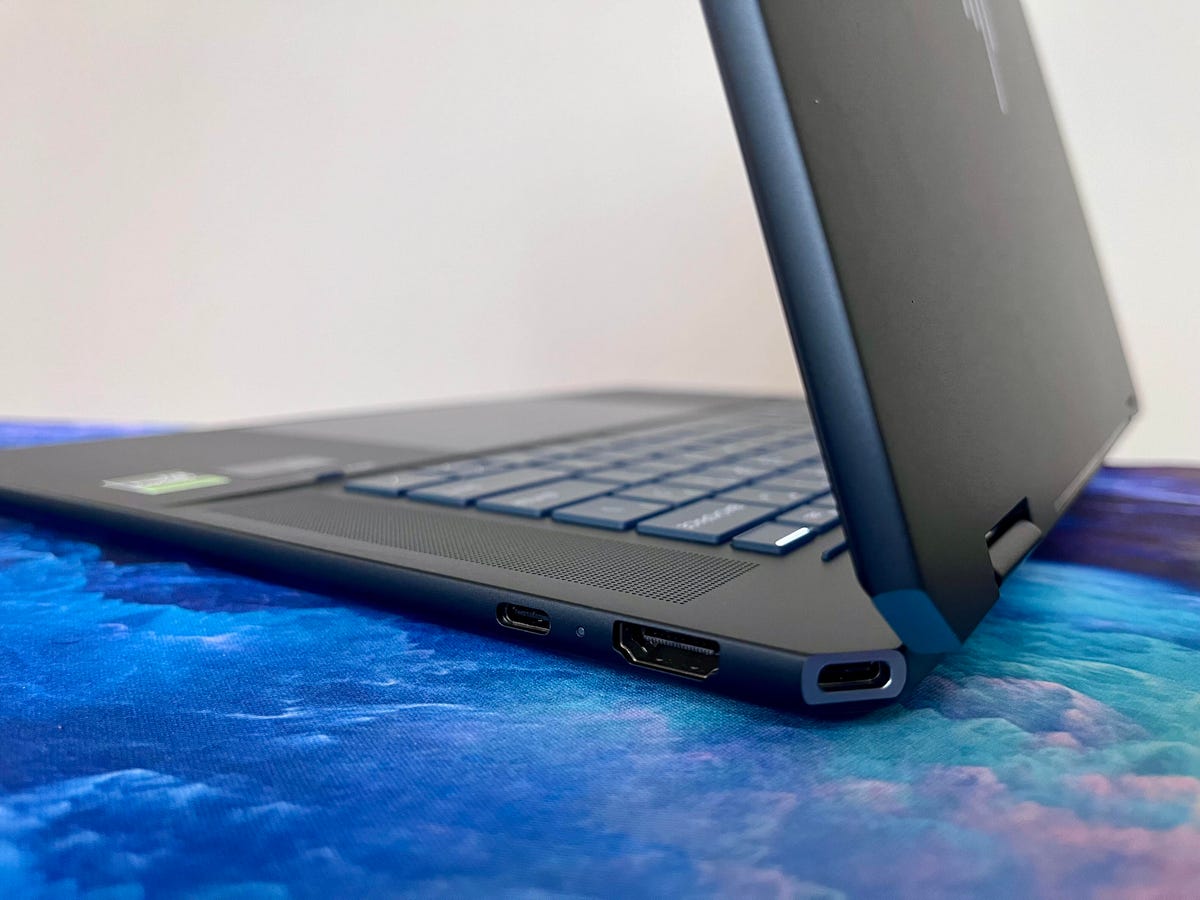
The port selection covers the basics with a pair of Thunderbolt 4 ports, a USB-A port, an HDMI port and a combo audio jack. Creators might have liked to see an SD card slot, but it didn’t make the cut.
Yes, its size is a bit awkward as a handheld tablet and the RTX 4050 upgrade may not bring you the graphics performance you desire, but the HP Spectre x360 16 remains a versatile and well-designed two-in-one. Its audio-visual output is excellent and makes the system a great pick for general home use when you aren’t using the giant OLED display for creative endeavors. Plus, it’s one of the few Windows machines with a design and build quality that can rival a MacBook. And with HP consistently offering a $400 discount for it, the Spectre x360 16 is much more affordable than Apple’s 16-inch MacBook Pro.
The review process for laptops, desktops, tablets and other computerlike devices consists of two parts: performance testing under controlled conditions in the CNET Labs and extensive hands-on use by our expert reviewers. This includes evaluating a device’s aesthetics, ergonomics and features. A final review verdict is a combination of both objective and subjective judgments.
The list of benchmarking software we use changes over time as the devices we test evolve. The most important core tests we’re currently running on every compatible computer include Primate Labs Geekbench 6, Cinebench R23, PCMark 10 and 3DMark Fire Strike Ultra.
A more detailed description of each benchmark and how we use it can be found on our How We Test Computers page.
Geekbench 6 (multicore)
Apple MacBook Pro 16 (M3 Max, 2023) 21482HP Victus 16 13501Dell Inspiron 16 Plus 7630 13250HP Spectre x360 14 12897Acer Swift X 16 12473HP Spectre x360 16 11459Lenovo Yoga 7i 16 9303
PCMark 10 Pro Edition
Acer Swift X 16 7645Dell Inspiron 16 Plus 7630 7071HP Victus 16 7038HP Spectre x360 14 6893Lenovo Yoga 7i 16 5988HP Spectre x360 16 5789
Cinebench R23 (multicore)
Apple MacBook Pro 16 (M3 Max, 2023) 24056HP Victus 16 18697Dell Inspiron 16 Plus 7630 17167Acer Swift X 16 16689Lenovo Yoga 7i 16 9476HP Spectre x360 14 8656HP Spectre x360 16 8096
3DMark Wild Life Extreme Unlimited
HP Victus 16 15836Dell Inspiron 16 Plus 7630 15620HP Spectre x360 16 12085Acer Swift X 16 7862HP Spectre x360 14 6026Lenovo Yoga 7i 16 3736
3DMark Fire Strike Ultra
Dell Inspiron 16 Plus 7630 5443Acer Swift X 16 4406HP Victus 16 4268HP Spectre x360 16 3669HP Spectre x360 14 2058Lenovo Yoga 7i 16 1277
Online streaming battery drain test
Apple MacBook Pro 16 (M3 Max, 2023) 1263Lenovo Yoga 7i 16 820HP Spectre x360 16 637Dell Inspiron 16 Plus 7630 608HP Spectre x360 14 595HP Victus 16 577Acer Swift X 16 257
System Configurations
| HP Spectre x360 16 | Microsoft Windows 11 Pro; Intel Core Ultra 7 155H; 16GB DDR5 RAM; Nvidia GeForce RTX 4050 graphics; 1TB SSD |
|---|---|
| HP Spectre x360 14 | Microsoft Windows 11 Pro; Intel Core Ultra 7 155H; 32GB DDR5 RAM; Intel Arc Graphics; 2TB SSD |
| Acer Swift X 16 | Microsoft Windows 11 Home; AMD Ryzen 9 7940HS; 16GB DDR5 6,400MHz RAM; 6GB Nvidia GeForce RTX 4050; 1TB SSD |
| Dell Inspiron 16 Plus 7630 | Microsoft Windows 11 Home; Intel Core i7-13700H; 16GB DDR5 4,800MHz RAM; 8GB Nvidia GeForce RTX 4060 graphics; 1TB SSD |
| HP Victus 16 | Microsoft Windows 11 Home; Intel Core i7-13700H; 16GB DDR5 RAM; 6GB Nvidia GeForce RTX 4050; 1TB SSD |
| Lenovo Yoga 7i 16 | Microsoft Windows 11 Home; 1.7GHz Intel Core i5-1355U; 16GB DDR5 5,200MHz RAM; 128MB Intel Iris Xe Graphics; 512GB SSD |
| Apple MacBook Pro 16 (M3 Max, 2023) | Apple MacOS Sonoma 14.1; Apple M3 Max (16-core CPU, 20-core GPU); 48GB unified memory; 1TB SSD |


















+ There are no comments
Add yours